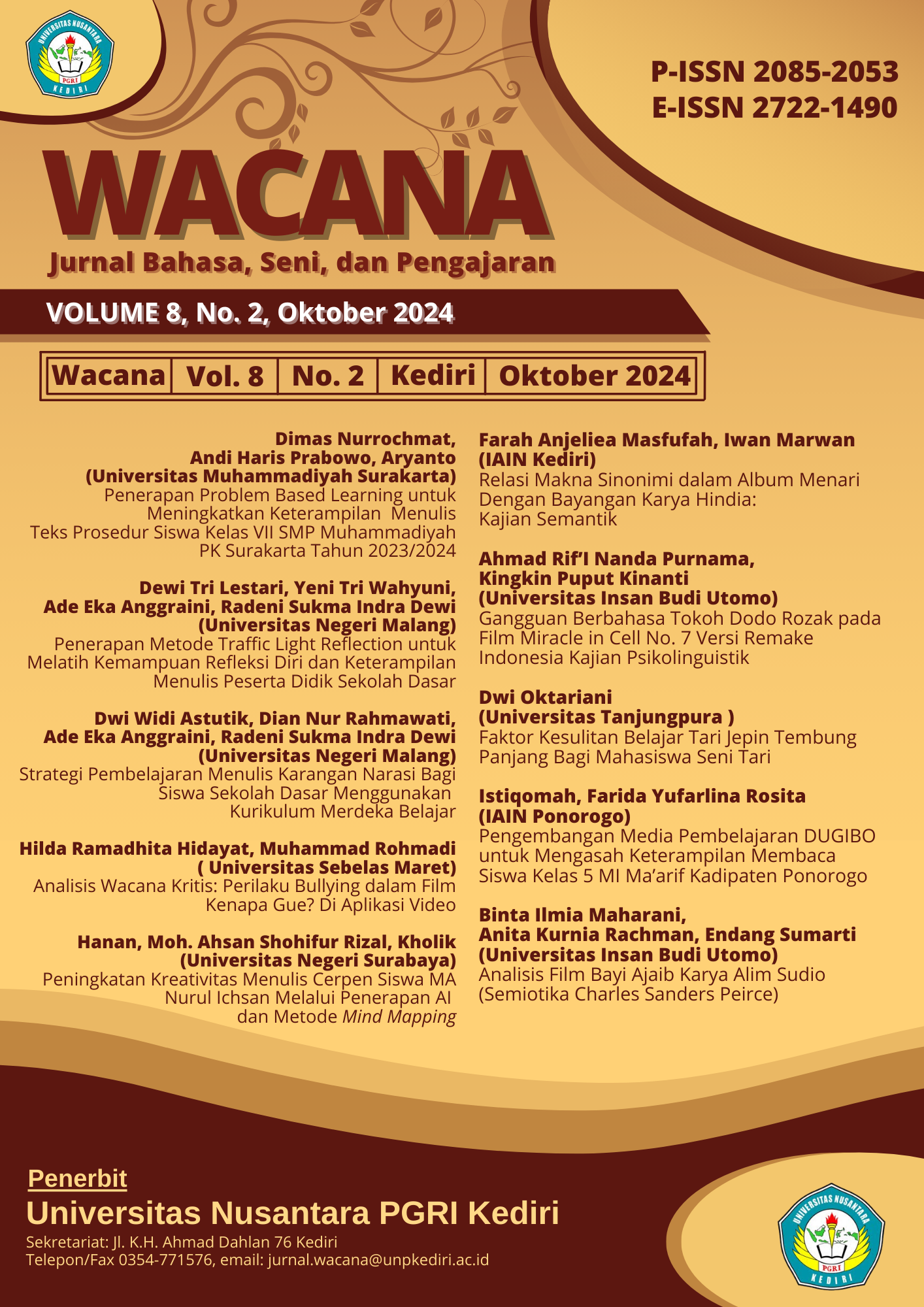Gangguan Berbahasa Tokoh Dodo Rozak pada Film Miracle in Cell No. 7 Versi Remake Indonesia Kajian Psikolinguistik
Language Disorder of the Character Dodo Rozak in the Film Miracle in Cell No. 7 Indonesian Remake Versions Psycholinguistic Studies
DOI:
https://doi.org/10.29407/jbsp.v8i2.23243Keywords:
language disorder, linguistic, psicolinguisticAbstract
This research delves into the language disorders portrayed by Dodo Rozak in the Indonesian film "Miracle in Cell No. 7," examining how individuals with intellectual disabilities interact linguistically. Grounded in psycholinguistics, the study employs a qualitative descriptive approach to analyze phonological, morphological, and syntactic deviations stemming from disrupted language development, often attributed to brain hemisphere impairments. Data, gathered through attentive listening and meticulous note-taking, were scrutinized utilizing matching techniques, specifically PUP and HBB. The findings illuminate a spectrum of linguistic errors. Phonological anomalies included phoneme alterations, omissions, and substitutions. Morphological irregularities manifested as incorrect affixation. Syntactic errors were evident in sentences that strayed from conventional language structures. This study underscores the film's depiction of language impairments, offering valuable insights into the specific linguistic challenges encountered by individuals with intellectual disabilities, and enriching our comprehension of psycholinguistic phenomena within the realm of cinematic representation. The study contributes to a deeper understanding of language disorders in a real world context.
References
Abdul, C. (2013). Fonologi bahasa Indonesia. Rineka Cipta, Jakarta.
Bloomfield, L. (1933). Language Chicago: Holt Rinehart and Wiston.
Dahniar, A., & Sulistyawati, R. (2023). Analisis campur kode pada TikTok podcast Kesel Aje dan dampaknya terhadap eksistensi berbahasa anak milenial: Kajian sosiolinguistik. ENGGANG: Jurnal Pendidikan, Bahasa, Sastra, Seni, Dan Budaya, 3(2), 55–65.
Habibie, W. (2021). Proses morfologi kata main: Afiksasi, reduplikasi, dan komposisi. Jurnal Skripsi Mahasiswa.
Hidayah, B. (2013). Afiksasi kata kerja masa lampau dalam bahasa Arab dan bahasa indonesia; analisis kontrastif. tafáqquh: jurnal penelitian dan kajian keislaman, 1(2), 114–129.
karismawati, k., utami, s. r., & marliana, n. l. (2021). Analisis fonologi pada anak down syndrome usia 10 tahun (studi kasus) dan implementasinya terhadap keterampilan berbicara teks deskripsi tematik di slb. Bahastra: Jurnal Pendidikan Bahasa Dan Sastra Indonesia, 6(1), 52–57.
Kuntarto, E. (2017). Memahami konsepsi psikolinguistik. Universitas Jambi.
Lestari, E. S., & Sudaryanto, S. (2020). Kesalahan ejaan bahasa Indonesia dalam karangan narasi mahasiswa Thailand dan kaitannya dengan perkuliahan analisis kesalahan berbahasa Indonesia. Lateralisasi, 8(1), 89–95.
Lestari, N. D., & Sukmawati, A. (2023). Analisis perubahan fonem dalam kemasan produk makanan dan minuman: Kajian fonologi. Narasi: Jurnal Kajian Bahasa, Sastra Indonesia, Dan Pengajarannya, 1(1), 12–23.
Liani, A., & Dafit, F. (2023). Kesantunan berbahasa dalam pembelajaran siswa di kelas rendah sekolah dasar. Jurnal Obsesi: Jurnal Pendidikan Anak Usia Dini, 7(6), 6798–6807.
Mufidah, N. I., & Antono, M. N. (2019). Gangguan berbahasa tokoh Abang dalam film Rectoverso “Malaikat Juga Tahu” (kajian psikolinguistik). Jurnal Pendidikan Bahasa Dan Sastra Indonesia Metalingua, 4(2), 71–76.
Murdiana, S., Nugraheni, Y., & Hardianti, D. (2019). Analisis sintaksis pada kalimat imperatif di naskah film Suicide Squad. Prosiding Seminar Nasional Mahasiswa Unimus, 2.
Nisa, F. T., Rahmayantis, M. D., & Sasongko, S. D. (2022). Analisis kesalahan berbahasa pada tabloid Kontan tataran morfologi edisi 19 Juli-25 Juli. Wacana : Jurnal Bahasa, Seni, Dan Pengajaran, 6(1), 66–70. https://doi.org/10.29407/jbsp.v6i1.18331
Paradida, Y. P., Ansiska, P., Tarigan, M. L., & Luhulima, F. D. N. (2023). Reduplikasi dalam kumpulan cerpen Atavisme karya Budi Darma. Prawara: Jurnal Pendidikan Bahasa Dan Sastra Indonesia, 4(2), 117–127.
Pratama, R. M., Sunarsih, E., & Zulfahita, Z. (2023). Interferensi morfologi bahasa Melayu terhadap bahasa Indonesia dalam film Sambas Tullah. Jurnal Pendidikan Bahasa Dan Sastra Indonesia Metalingua, 8(1), 56–61.
Riandini, Z. N., Fatimah, S. N., Ugiyanto, F. E., & Laily, I. N. (2022). Analysis of error in Indonesian language at the morphological level in the discussion of buying online on Instagram. Wacana : Jurnal Bahasa, Seni, Dan Pengajaran, 4(2), 44–50. https://doi.org/10.29407/jbsp.v4i2.17644
Rosalianisa, R., Purwoko, B., Nurchayati, N., & Subrata, H. (2023). Analisis kemampuan berbahasa dan mengenal konsep bilangan anak melalui teknologi pada era digital. Jurnal Obsesi: Jurnal Pendidikan Anak Usia Dini, 7(2), 1996–2010.
Sanulita, H., Lestari, S. A., Syarmila, S., Yustina, I., Atika, A., Nurillah, S., Iqbal, M., Elofhia, L., & Annisa, A. (2024). Keterampilan berbahasa reseptif: Teori dan pengajarannya. PT. Sonpedia Publishing Indonesia.
Sati, P. L., Poerwadi, P., Asi, Y. E., Nurachmana, A., & Lestariningtyas, S. R. (2023). Prinsip kesantunan berbahasa dalam film Layangan Putus dan implikasinya terhadap pembelajaran bahasa Indonesia di smp. Prosiding Seminar Nasional Pendidikan, Bahasa, Sastra, Seni, Dan Budaya, 2(1), 108–125.
Suharti, S., Hum, S., Khusnah, W. D., Sri Ningsih, S. S., Shiddiq, J., Saputra, N., Heri Kuswoyo, S. S., Jalal, N. M., Dhari, P. W., & Ratna Susanti, S. S. (2021). Kajian psikolinguistik. Yayasan Penerbit Muhammad Zaini.
Suryani, A., Rizky, M. L., & Nuryani, N. (2022). Kontak bahasa Betawi dan Minangkabau di komunitas mahasiswa Minangkabau di Ciputat. Pena Literasi, 5(2), 126–135.
Taufiq, M., Maliki, D. O., Maldini, A. S., Ekamartha, K. N., Saputra, K. N. C., Ahmad, S. H., Pillardien, E., & Sholihatin, E. (2023). Pentingnya etika berbahasa sebagai upaya pencegahan kasus kejahatan berbahasa di media digital. Bureaucracy Journal: Indonesia Journal of Law and Social-Political Governance, 3(2), 2116–2125.
Downloads
Published
Issue
Section
License
Copyright (c) 2024 Ahmad Ri'i Nanda Purnama, Kingkin Puput Kinanti

This work is licensed under a Creative Commons Attribution-ShareAlike 4.0 International License.













